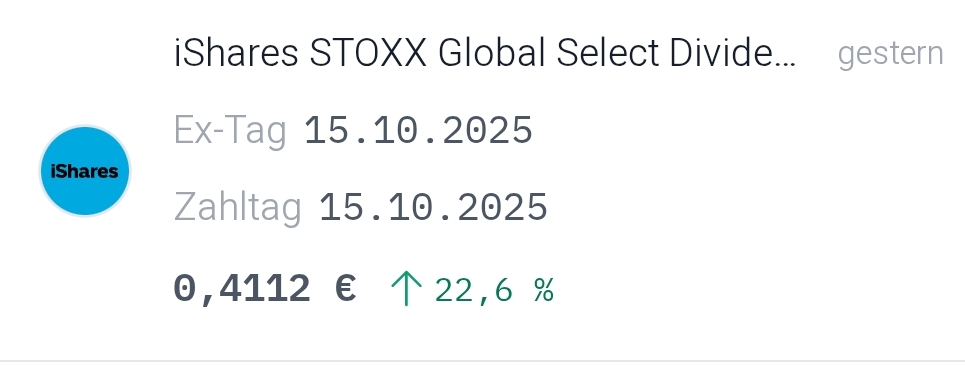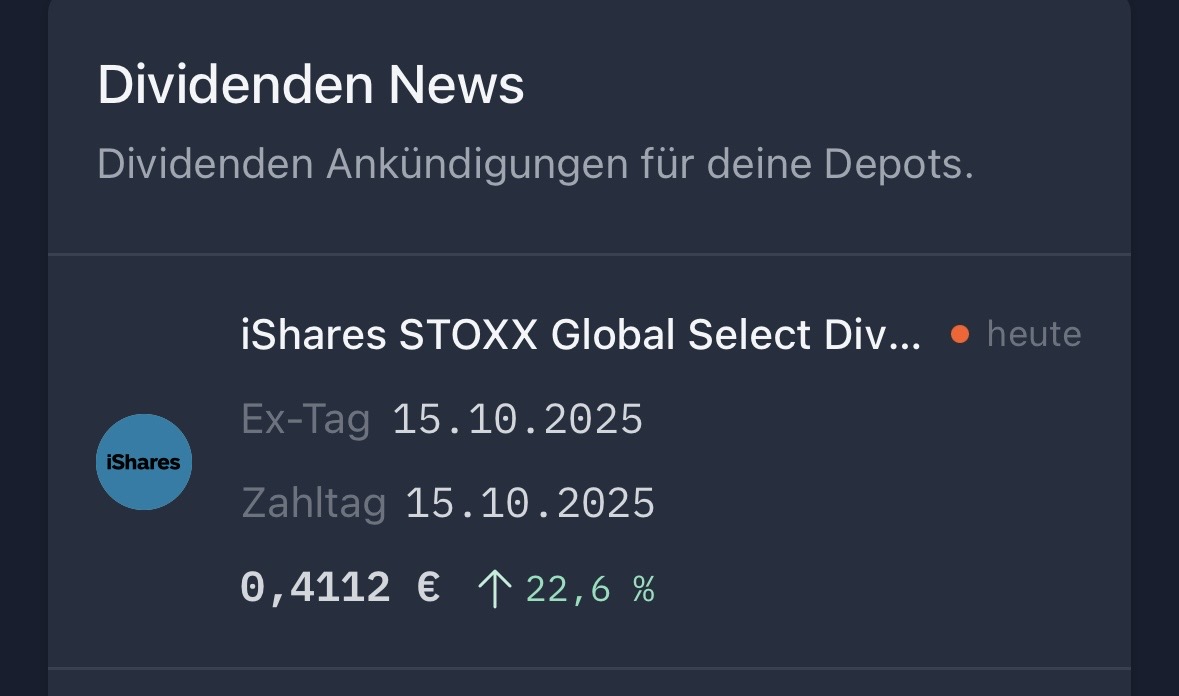Adding up to this dividend monster 🤑

iShares STOXX Global Select Dividend 100
Price
Discussion sur ISPA
Postes
111My review for October 2025: honest figures, 100% unadorned
October was the month of big decisions and consistent adherence to the plan! While the crypto market was still euphorically looking upwards, I think I recognized the signals: The bull market came to an end around October 21, For me it was time for an exit from this asset class. With the exception of a small holding of a few euros in $BTC (+0,44 %) as a souvenir, I am completely out of crypto. Everything was shifted to my crypto successor portfolio. Sure, there was a brief tingling sensation and I wondered whether I was getting out too early.
But there are plans precisely for scenarios like this. To conquer emotions that jeopardize profits and let discipline prevail. And how am I feeling now after the exit? Pure relief! Finally no longer sitting there hoping that things will rise to my desired level or stay there. I'll reveal in detail what happens next for me in the coming year.
At the same time, the half-year bonus was added to the portfolio, the dividend base was broadened and I was able to relax and let it all sink in while hiking in the autumn air. My portfolios continued to do their job. The cash flow is flowing. Time for a review of a month that shows that a strategy beats FOMO.
Overall performance
October brought another boost for me in some assets, while others consolidated somewhat. Perhaps this is already a sign that stocks are positioning themselves for the year-end rally? I am firmly convinced that the current shutdown in the US administration will not act as a brake here. My key performance indicators for my overall portfolio at a glance:
- TTWROR (month under review): +1,39% (previous month: +1.76%)
- TTWROR (since inception): +77,04%
- IZF (month under review): +17,65% (previous month: +9.64%)
- IZF (since inception): +10,94%
- Delta: +1,160.94€
- Absolute change: +€2,224.10
Performance & volume
$AVGO (+2,71 %) is still my largest single position, but is losing momentum this month. However, its distance to the other positions is large enough, no one in the portfolio can hold a candle to my +337% share. But $NFLX (-2,67 %) and $GOOGL (+0,87 %) and others are trying hard to get there. Alphabet is now in the top 5 by volume and performance. I like the company. With YouTube and Cloud Services, they have good cash cows that enhance traditional search. And this is now also being upgraded with Gemini integrated into search. And Nano Banana ... wow.
Google is not always the leader, but it is always catching up. The competition between the tech giants is a spectacle that I love to watch.
And yet I prefer to rely on the more stable industries. Even the $BAC (-0,14 %) and $WMT (+0,35 %) continue to cut a good figure. Boring, but still good businesses that generate income. That's what I want! These are really two sectors that I have become very fond of. Nevertheless, the red lantern once again goes to $TGT (+0,92 %) which continue to have a hard time. But I'm sticking with it and buying more. Because $TGT (+0,92 %) is systemically relevant and will not go to the dogs. They just have problems with theft and competition.
Size of individual share positions by volume in the overall portfolio:
Share (%) of the total portfolio and associated securities account:
$AVGO (+2,71 %) 3.14% (main share portfolio)
$NFLX (-2,67 %) 1.72% (main share portfolio)
$WMT (+0,35 %) 1.65% (main share portfolio)
$BAC (-0,14 %) 1.48% (main share portfolio)
$GOOGL (+0,87 %) 1.41% (main share portfolio)
Smallest individual share positions by volume in the overall portfolio:
Share (%) of the total portfolio and associated securities account:
$NOVO B (+0,63 %) 0.45% (main share portfolio)
$BATS (-1,51 %) : 0.50% (crypto follow-on portfolio)
$GIS (-0,03 %) 0.55% (main share portfolio)
$TGT (+0,92 %) 0.58% (main share portfolio)
$MDLZ (-1,15 %) 0.60% (main share portfolio)
Top-performing individual stocks
Shares with performance since initial purchase (%) and the respective portfolio:
$AVGO (+2,71 %) : +337% (main share portfolio)
$NFLX (-2,67 %) +151% (main share portfolio)
$GOOGL (+0,87 %) +99% (main share portfolio)
$WMT (+0,35 %) +77% (main share portfolio)
$BAC (-0,14 %) + 74% (main share portfolio)
Flop performer individual stocks
Shares with performance since initial purchase (%) and the respective portfolio:
$TGT (+0,92 %) : -35% (main share portfolio)
$GIS (-0,03 %) -34% (main share portfolio)
$NKE (+0,45 %) : -32% (main share portfolio)
$NOVO B (+0,63 %) -28% (main share portfolio)
$CPB (+0,5 %) : -27% (main share portfolio)
Asset allocation
Due to my crypto reallocation, the ETF share is increasing. My asset allocation is as follows:
ETFs: 41.5%
Equities: 58.4%
Crypto: less than 0.01%
P2P: less than 0.01%
Investments and subsequent purchases
I have invested the following amounts in savings plans:
Planned savings plan amount from the fixed net salary: €1,030
Planned savings plan amount from the fixed net salary, incl. reinvested dividends according to plan size: €1,140
Savings ratio of the savings plans to the fixed net salary: 49.75%
In addition, there were the following additional investments from returns, refunds, cashback, etc. as one-off savings plans/repurchases:
Subsequent purchases/one-off savings plans as cashback annuities from refunds: € 73.00
Subsequent purchases/one-off savings plans as a cashback annuity from bonuses: € 894.97
Subsequent purchases from other surpluses: €31.00
Automatically reinvested dividends by the broker: €2.76 (function is only activated for an old custody account, as I otherwise prefer to control the reinvestment myself)
Additional purchases from crypto sales: €1,604.86
Additional purchases were made in various custody accounts outside the regular savings plans:
Number of additional purchases: 9
124.97€ for $SPYD (+0,02 %)
770,00 $JEPQ (+1,01 %)
28.00€ for $JEGP (-0,43 %)
45,00€ for $GGRP (+0,06 %)
477,77€ for $DXSA (-0,31 %)
252,51€ for $EXX5 (+0,17 %)
270,99€ for $SHEL (-1,62 %)
102,97€ for $HSBA (-1,13 %)
445.58€ for $BATS (-1,51 %)
Passive income from dividends
My income from dividends amounted to € 148.90 (€ 81.32 in the same month last year). This corresponds to a change of +82.43% compared to the same month last year. The strong increase is due to the fact that my large Vanguard ETFs postponed the distribution to the reporting month. Further key data on the distributions follows:
Number of dividend payments: 26
Number of payment days: 10 days
Average dividend per payment: €5.73
average dividend per payment day: €14.89
The top three payers are:
My passive income from dividends (and some interest) mathematically covered 16.05% of my expenses in the month under review.
Crypto performance
My crypto portfolio is distorted by the sell-off and will not be calculated again until I get back in. That will now take quite a while. I got out later than I wanted to, but still made a good profit. Only the Oracle of Delphi knows whether I am right with my approach. My key figures:
Performance in the reporting period: -
Performance since inception: -
Proportion of holdings for which the tax holding period has expired: 100%.
Crypto share of the total portfolio: less than 0.001%
Now it's time for the same thing as last crypto winter. Learning and understanding. And the current crypto winter hasn't even started yet. However, I think that prices will fall less sharply than in previous cycles and that the decline will be more orderly due to institutional adaptation. That's a good thing right now, as it makes it easier to get back in.
Performance comparison: portfolio vs. benchmarks
A comparison of my portfolio with two important ETFs shows:
TTWROR (current month): +1,39%
$VWRL (+0,32 %) : +4,66%
$VUSA (+0,23 %) : +2,76%
I am lagging behind the ETFs. 🤷🏼♂️
Risk ratios
Here are my risk figures for the month under review:
Maximum drawdown: 1.94% (YTD: 17.17%)
Maximum drawdown duration: 13 days (YTD: 702 days)
Volatility: 2.51% (YTD: 28.02%)
Sharpe ratio: 7.03 (YTD: 0.39)
Semi-volatility: 1.69% (YTD: 20.82%)
A drawdown of only 1.94% in October? That's exactly how it should be. While the markets trended sideways to slightly upwards, my portfolio remained frighteningly boring. And in the best sense of the word. The volatility of 2.51 % and the semi-volatility of 1.69 % confirm that my crypto exit has increased the stability of my portfolio. No more wild swings, just solid growth. The Sharpe ratio of 7.03? Brutally good. Maybe Trump's China deal helped the markets, maybe it was just my perfect timing. No matter! The figures speak for themselves: strategy beats chaos.
Outlook
Thanks for reading, this time I want to keep the outlook deliberately short. I'm glad that you're honoring the several days of work in front of the computer in the evenings when others are chilling with Netflix with your lifetime. I don't have anything else for the miscellaneous category this time. If you want to know what else is on my mind, please refer to the August review. I'll have something to say about that next December, I think. Stay safe and sound!
👉 Would you like to see my review as an Instagram Carousel post?
Then follow me on Instagram:
📲 In addition to the portfolio and budget review, there are currently three posts a week: @frugalfreisein
Please pay close attention to the spelling, unfortunately there are too many fake and phishing accounts on social media. I have also been "copied" several times now.
👉 How was your month in the portfolio? Do you have any tops and flops to report?
Leave your thoughts in the comments!
ETF selection makes sense?
Hello everyone,
I would be delighted if you could give me a few tips regarding ETFs. I would like to invest in three ETFs at the same time, but I'm not sure whether that makes sense. I'm 48 and think it's great if you can reinvest the dividends yourself and see a payout in your account.
ETFs would be $VWRL (+0,32 %) , $TDIV (+0,02 %) un$ISPA (+0,14 %) .
Also with ratio information. The focus should later be the pension.
Thank you very much for your opinions/tips
I (unfortunately) also have (too) many ETFs running. (60% ETFs/40% equities = core satellite). I like security, but I would like to take a little more return opportunities with me... works quite well so far.
My allocation (based on my entire portfolio):
- MSCI Word (the classic) 35 %
- S+P 500 TOP 20 (VERY VOLANTIL, but highest return opportunity!) 5 %
- MSCI China Tech (I believe in the market for the next 10-20 years) 4.8 %
The following 3 still with a very small savings rate:
- Asia Pacific ex Japan Equity etf (4%) and
- MSCI Eur.Fin.Se. Reg. (3%)
- MSCI Japan (2%)
.... as balance/diversification ...
All ETF's are saved monthly by me. The big ones are supposed to run until 15 k each and then I save a similar one further (FiFo for payout already take something into account)...
Renter ETF for bores
A bit of risk-off as part of my portfolio restructuring
Dividend increases significantly
Compared to last October, the dividend from the $ISPA (+0,14 %) considerably. 😃
Also performing better than my favorite ETF lately $TDIV (+0,02 %) .

What's next....?
Good morning,
I am quite new to the subject of investing etc. My knowledge ? I'm sure 99% of you have more.
And that's where I really need help. I am 39 and would like to build up a cash flow with dividends. Yes, I know that investing would be better in the long term. But I realized first hand how a little cold can lead you to the intensive care unit with 9 months of sick leave (including rehab etc).
That's when I realized that you also live in the here and now. Of course I also want to think about tomorrow, but I want to be able to do both. I would like to start with 250€ /month. I have in mind etf like $HMWO (+0,06 %) , $VHYL (+0,12 %) , $ISPA (+0,14 %) ,$TDIV (+0,02 %)
$ZPRG (-0,01 %) , $EUHD (-0,11 %)
$VWRL (+0,32 %) in mind.
And yet I am unsure . How much in whom, which one do I take ? should I possibly consider others ? Does the selection make sense at all? Do I want a distribution every month (would be great)?
At the moment I don't need the distribution and would reinvest it.
So many question marks buzzing around in my head .... Do you have any advice?
Thank you very much
Pharma ☑️
A sector that has lost so much ground in recent years, I think it's time to put something in the portfolio, I was undecided between $MRK (-0,58 %) e $PFE (+1,22 %) but seeing the data the former has had a steady growth in earnings, revenues and R&D investment, as well as a lower payout ratio than Pfizer and a higher dividend increase over time, more than sustainable by the way, another interesting factor is the exchange rate, a purchase gone through at the exchange rate of 1.1737, much better than the previous purchase of $MAIN (+1,1 %) which took place for 1.1699 eur/usd.
I would have loved to have added$O (+0,85 %) to ride the wave of the rate cut but the broker Directa only reserves it for "professional" clients, a scam....
As things stand right now I would say that for the next month I am going to add an ETF between $ISPA (+0,14 %) e $VHYL (+0,12 %) , I intend to have both in the future but following a contrarian strategy, that is, buying the one that has lost the most in the past month (or gained the least).
My review for August 2025: facts, figures and data - honest and unembellished
August gave us another real midsummer and showed its best side on some days. For me, it was the perfect opportunity to pursue one of my hobbies: Swimming, swimming and swimming again. I enjoyed every minute in the now cooler water. There was no hiking this month, but the swimming made up for it completely. I'm slowly looking forward to cooler temperatures again, because the cold adaptation for ice swimming is already calling! But before we head into fall, it's time for a look back.
Overall performance
After the brief consolidation caused by the new Trump tariffs, my portfolio recovered quickly and showed a stable, slightly positive performance in August. The prospect of interest rate cuts by the Fed provided a small boost, but there were no major movements. Typical summer slump. But, as expected, what had to come arrived on time: the distributions. My key performance indicators for my overall portfolio at a glance:
- TTWROR (month of August): +1.01 % (previous month: +3.82 %)
- TTWROR (since inception): +73,69 %
- IZF (month of August): +12.50 % (previous month: +46.14 %)
- IZF (since inception): +10,79 %
- Delta: +794.74 €
- Absolute change: +1,850.61 €
Performance & volume
My class leader continues to expand its dominance. If this continues, it will soon become a decisive factor in overall performance. The $BOA rises into the top 5 by volume, $SAP (+0,47 %) falls back. Rising in terms of performance$MAIN (+1,1 %) and there, too, the$SAP (+0,47 %) falls back. I also notice something about the winners of the red lantern in terms of performance:$NOVO B (+0,63 %) has reached the bottom basement, once one of my very strongest stocks. So the tide is turning. Opportunity to buy more? Instead$CPB (+0,5 %) has risen from the cellar. But this share still has a long way to go.
Size of individual share positions by volume in the overall portfolio:
Share (%) of total portfolio and associated portfolio:
- $AVGO (+2,71 %) : 3.30 % (main share portfolio)
- $NFLX (-2,67 %) 1.98 % (main share portfolio)
- $WMT (+0,35 %) 1.72 % (main share portfolio)
- $FAST (-0,45 %) s: 1.69 % (main share portfolio)
- $BOA 1.45 % (main share portfolio)
Smallest individual share positions by volume in the overall portfolio:
Share proportion (%) of the total portfolio and associated securities account:
- $SHEL (-1,62 %) : 0.42 % (crypto follow-on portfolio)
- $NOVO B (+0,63 %) 0.49 % (main share portfolio)
- $HSBA (-1,13 %) 0.54 % (crypto follow-on portfolio)
- $TGT (+0,92 %) 0.57 % (main share portfolio)
- $GIS (-0,03 %) 0.61 % (main share portfolio)
Top-performing individual stocks
Shares with performance since initial purchase (%) and the respective portfolio:
- $AVGO (+2,71 %) : +328 % (main share portfolio)
- $NFLX (-2,67 %) : +176 % (main share portfolio)
- $FAST (-0,45 %) +83 % (main share portfolio)
- $MAIN (+1,1 %) : +79 % (main share portfolio)
- $SAP (+0,47 %) +74 % (main share portfolio)
Flop performer individual stocks
Shares with performance since initial purchase (%) and the respective portfolio:
- $TGT (+0,92 %) : -36 % (main share portfolio)
- $GIS (-0,03 %) -31 % (main share portfolio)
- $UPS (+0,33 %) -26 % (main share portfolio)
- $NKE (+0,45 %) -25 % (main share portfolio)
- $NOVO B (+0,63 %) -21 % (main share portfolio)
Asset allocation
My asset allocation is as follows:
- ETFs: 38.3 %
- Equities: 59.0 %
- Crypto: 2.60%
- P2P: less than 0.01%
Investments and subsequent purchases
Here is a small overview of what I have invested via savings plans according to my fixed planning.
- Planned savings plan amount from the fixed net salary: €1,030
- Planned savings plan amount from the fixed net salary, incl. reinvested dividends: €1,140
- Savings ratio of the savings plans to the fixed net salary: 49.75
In addition, there were the following additional investments from returns, refunds, cashback, etc. as one-off savings plans/repurchases:
- Subsequent purchases/one-off savings plans as cashback annuities from refunds: € 79.00
- Subsequent purchases/one-off savings plans as a cashback annuity from bonuses/incentives from the KK: € 20.00
- Subsequent purchases from other surpluses: € 30.00
- Automatically reinvested dividends by the broker: € 3.01 (this function is only activated for an old custody account, as I otherwise prefer to manage the reinvestment myself)
Additional purchases were made:
- Number of additional purchases: 3
- 55.00 € for $JEGP (-0,43 %)
44.00 € for $GGRP (+0,06 %)
30.00 € for $FGEQ (+0,1 %)
295.08 € for $DXSA (-0,31 %) (funds from the sale of a $ETH (+0,29 %) tranche)
If you want to know how my cashback pension tops up my share and ETF pension, please write it in the comments.
Passive income from dividends
My income from dividends amounted to €128.42 (€92.61 in the same month last year). This corresponds to an increase of +38,67 % compared to the same month last year. The following is further key data on the distributions:
- Number of dividend payments: 22
- Number of payment days: 12 days
- Average dividend per payment: € 5.83
- average dividend per payment day: € 10.70
The top three payers are:
My passive income from dividends (and some interest) mathematically covered 14.94% of my expenses in the month under review.
Crypto performance
My crypto portfolio was characterized by the partial sale of a $ETH (+0,29 %) tranche as part of my "crypto succession strategy". Around € 298 in Etherium was taken off the table.
Here are some key figures:
- Monthly performance portfolio: +0.29 %
- Performance since inception: +134.35 %
- Share of holdings for which the tax holding period has expired: 98.55 %.
- Crypto share of the total portfolio: 2.20 %
The sale of the tranche explains the decline in the crypto share from 2.6% to 2.2%
As a "follower" of the crypto cycle, I am increasingly accepting the idea that the cycle is still in tact, but is expanding. The reason for this should be the ETF purchases and the activities of the crypto treasury companies. Retail still seems to be asleep. The playing field is very exciting, if only from a macroeconomic perspective. I can only advise looking into the cycle and issues such as money creation and the correlation between the M2 money supply and $BTC. Although I am not a fan of cryptocurrencies, I think they are a sensible component of a balanced portfolio.
Performance comparison: portfolio vs. benchmarks
A comparison of my portfolio with two important ETFs shows
- TTWROR (current month): +1,01 %
- $VWRL (+0,32 %) : -0,33 %
- $VUSA (+0,23 %) : -1,13 %
Outlook and a private bonus
My Carousel posts of the portfolio review and budget review always start on the hook slide with a background image from my month. These are usually places I've visited or moments that have moved me. This time it's the same, although a CT scan would almost be more appropriate.
A chest CT confirmed what I had been wondering about for some time: my ascending aorta is dilated. This is a consequence of my congenital heart valve defect. Fortunately, it was discovered early before it could develop into an aneurysm, dissection or even rupture. A classic chance discovery, a stroke of luck. I was able to keep the heart valve "in check" for a long time, and fortunately there are currently no worse findings for it. But the diagnosis of the ascending aorta now brings certainty: an operation will certainly be necessary at some point.
Why am I sharing this here? Because it has taught me humility once again. The diagnosis isn't nice, but it's not a surprise either. Perhaps my v. A. more active lifestyle since corona has contributed to the fact that it is stable today and still allows me to do a lot: sporting activity, which I have fought my way back over the years. The restrictions that already apply to avoid pressure peaks on the aorta are minimal. My quality of life is still very high.
My conclusion: Keep fit, go for check-ups and take your body seriously. Invest in your health and fitness. Our deposits are only worth as much as our health allows us to enjoy them.
So I will be able to visit the cardiologist and radiologist even more regularly in future, an honor! (irony off). Everything will be fine!
👉 You want my review as an Instagram post?
Then follow me on Instagram:
📲 In addition to the portfolio and extra budget review, you'll also find regular posts there: @frugalfreisein
Please pay close attention to the spelling, unfortunately there are too many fake and phishing accounts on social media. I have already been "copied" several times.
👉 How was your August at the depot? Do you have any tops and flops to report?
Leave your thoughts in the comments!
Pure motivation
🚀 Motivation $ISPA (+0,14 %) pure: Dividend ETFs are like a money tree in your portfolio 🌳💸 - you plant it once and it produces cash flow year after year. Regardless of whether prices fluctuate or the market causes drama: the dividend rings reliably in your account.
It's like swimming training:
It feels tough at first, length after length, day after day. But you get stronger with every stroke.
Titres populaires
Meilleurs créateurs cette semaine




















